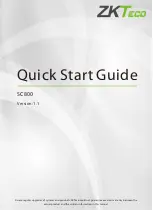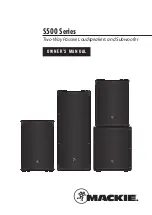
Epsilon
13
Epsilon SCU Set-up
The fuse protrudes from the rear of the voltage selector plug. Remove it to check its rating. To change the voltage
selector, pull the gray selector plug out of the fuse block, turn it so that the correct voltage marking is up, and plug the
selector back into the fuse block. (NOTE: The SCU has been shipped in the 120V position. The fuse for the 220V and
240V position is in the compartment adjacent to the active fuse in the fuse block). Verify that the correct voltage reading
shows in the window. Replace the fuse by inserting it into the rear of the selector plug, then plug the fuse block back
into the power module.
We recommend that you plug the SCU into a wall outlet that is unswitched and always “hot,” so that the SCU’s amplifier
circuitry can remain warmed-up and stabilized for best sound quality.
Signal connections
The SCU has inputs and outputs for both balanced and unbalanced configurations. The unbalanced connections are
standard “phono” type connectors, while the balanced connections are “XLR” types commonly used for low-impedance
microphones. The input and output connections to and from the SCU may be all balanced, all unbalanced, or any
combination of balanced and unbalanced.
We recommend that you use the balanced connections if available on your other equipment; but if you do, please see
the Appendix: Balanced Connnection Notes. This manual assumes that all of your balanced connections conform to
AES standard wiring, in which pin 1 is ground (common), pin 2 is “+” and pin 3 is “-”. It is vital that you know whether
the amplifiers conform to AES standards or are polarity reversed.
Inputs to the SCU
Connect the preamp/audio control center’s left and right channel outputs to the SCU’s left and right input connectors.
Be certain to connect left channel to left and right to right.
Outputs to the Mid/High Frequency Amplifiers
Connect the SCU’s left and right bypass outputs to the left and right channel inputs, respectively, of the amplifier(s)
that drive the Epsilons’ HIGH PASS inputs for the Mid/High frequency section.
Outputs to the Woofer Amplifiers
Connect the SCU’s left and right bass out outputs to the left and right channel inputs, respectively, of the amplifiers
that drive the Epsilons’ LOW PASS inputs for the Woofer section.
Servo connections from the loudspeakers to the SCU
Plug one end of the special 4-pin XLR servo cable into the left loudspeaker’s SERVO output jack. Plug the other end
into the SCU’s left servo input jack. Repeat these connections for the right speaker’s SERVO output and the SCU’s
right servo input jack.
WARNING: DO NOT connect the right speaker’s SERVO output to the SCU’s left servo jack or vice versa.
Incorrect hook-up can lead immediately to woofer and/or amplifier failure.
You may now move the speakers into their initial positions for listening evaluation.
EPSILON SERVO CONTROL UNIT SET-UP
Amplifier gain matching
Now that the system cable connections are complete, it is time to set-up the controls on the SCU. This is when we
must consider the gain specification of the various amplifiers.
Basic to the operation of the Epsilon System is that the gains of the two woofer amplifiers be nearly identical, within a
fraction of one dB, and that the gains of the two mid/high amplifiers be nearly identical, also within a fraction of one db.
Summary of Contents for IRS Epsilon
Page 1: ...Infinity Systems Inc 250 Crossways Park Dr Woodbury New York 11797 REV 0 03 2001...
Page 4: ...Epsilon 4 Quick Connect Guide for Balanced Inputs...
Page 5: ...Epsilon 5 Quick Connect Guide for Balanced Inputs...
Page 6: ...Epsilon 6 Epsilon Loudspeaker Quick Connect Guide for Unbalanced Inputs...
Page 7: ...Epsilon 7 Epsilon Loudspeaker Quick Connect Guide for Unbalanced Inputs...




































